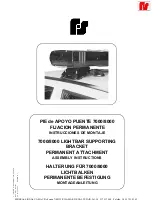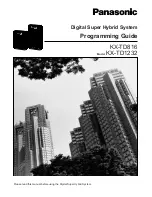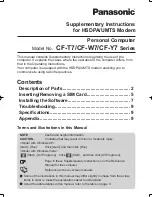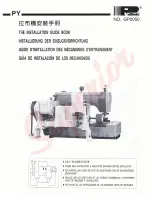
GB
GB
36
37
INSTALLATION - ELECTRICAL/ELECTRONIC COMPONENTS
(AWD CONFIGURATION)
To install an all-wheel drive system in your caravan, two separate electronic systems must be
assembled� These two systems are configured via the manual control before the first start-up,
but only a few elements need to be changed during the installation�
Start wiring your second Berger Titanium manoeuvring aid by following the same procedures
described in the previous section „Installation - Electrical/Electronic components“� Fig�7 shows
the wiring diagram for this rear axle assembly� Fig�8 can also be used as a general overview of
the wiring of the double axle� Follow these diagrams closely to ensure that the drive units are
powered as intended and do not work against each other during operation�
As far as the battery cables are concerned, the same mains disconnector can be used for both
systems� To do this, connect the second electronic control unit with a piece of cable from the
isolation key to the box itself� Only one positive battery cable should be connected to the batte-
ry itself, with two cables then splitting via inline fuses from the isolating switch to the respective
boxes� Use Fig�8 as a reference�
To complete the electrical set-up, attach the data cable (4) between the corresponding connec-
tors (Fig�3�DAT) in the electronic control units (2)� Make sure that it is firmly seated�
Follow the section „Operation - Remote Control Coupling“ in this manual carefully to learn
how to set up your remote control for correct operation of the AWD system�
OPERATION - SAFETY GUIDELINES
Caution� Please read these safety guidelines carefully BEFORE attempting to operate the mano-
euvring aid�
Always check the manoeuvring aid for any damage before use�
Always ensure that the ground clearance is reduced by approximately 50 mm where the mano-
euvring aid is fitted�
Keep a maximum distance of 5 metres between the remote control and the control unit so as
not to block the wireless signal transmission�
Note that the manoeuvring aid increases the weight of your caravan or trailer� This reduces the
payload of the caravan�
Always make sure that the castors are completely uncoupled from the tyres when the manoeuv-
ring aid is not in use� This is better for the tyres and for the manoeuvring aid�
Always make sure that the drive rollers of the manoeuvring aid are completely uncoupled
before towing/moving the caravan with a vehicle or under your own power� Otherwise, damage
may occur to the tyres, the towing vehicle and the manoeuvring aid�
Always make sure that the battery disconnect switch is turned off after using the manoeuvring
aid, the key is removed and the manoeuvring aid is parked in a safe place, out of reach of child-
ren or unauthorised persons�
Always make sure that the remote control is kept in a safe place, out of the reach of children or
unauthorised persons�
After manoeuvring, always apply the handbrake before releasing the drive rollers from the tyres�
DO NOT rely on the manoeuvring aid to act as a brake� DO NOT exceed the stated maximum
load capacity (SWL)� DO NOT attempt to move or tow your vehicle with the drive rollers at-
tached to the wheels� DO NOT make any modifications to the manoeuvring aid (mechanical or
electronic)� This can be very dangerous! There is no warranty claim and we cannot guarantee
the function of the manoeuvring aid if modifications have been made� Fritz Berger GmbH is not
liable for damage caused by improper installation, operation or modification�
OPERATION - FUNCTIONS OF THE REMOTE CONTROL
Use Fig�1 to familiarise yourself with the structure of the remote control (1)�
Switching on:
Fig�1�A = Power button (press twice)
Fig�1�B = LED display�
Movement controls:
Fig�1�C = Forward [F]
Fig�1�D = Forward right [FR]�
Fig�1�E = Forward Left [FL]
Fig�1�F = Reverse Right [RR]
Fig�1�G = Reverse Left [RL]
Fig�1�H = Reverse [R]
Controls for engaging and disengaging the clutch:
Fig�1�I = Engage button [ENG]
Fig�1�J = Disengage button [DENG]�
Fig�1�K = Automatic switch-on button [FN]�
The remote control (1) is powered by two 1�5 V „AAA“ batteries� To insert the batteries, you
must remove the rear casing of the remote control as shown in Fig� 2� Make sure that only
leak-proof batteries are used� Check with your local authorities for the correct disposal of used
batteries� Remove the batteries from the remote control if it will not be used for a long time�
Press the power button twice (Fig�1�A) to switch on the remote control� As soon as it is swit-
ched on, the LED (fig�1�B) lights up� If the remote control has not been used for 60 seconds, it
switches off�
Содержание 356280
Страница 4: ...DE DE 6 7 TECHNISCHE REFERENZDIAGRAMME Abb 1 Abb 2 Abb 3 Abb 4...
Страница 15: ...GB GB 28 29 TECHNICAL REFERENCE DIAGRAMS Fig 1 Fig 2 Fig 3 Fig 4...
Страница 16: ...GB GB 30 31 Fig 5 Fig 7...
Страница 26: ...FR FR 50 51 SCH MAS DE R F RENCE TECHNIQUES...
Страница 37: ...IT IT 72 73 SCHEMI TECNICI DI RIFERIMENTO...
Страница 48: ...NL NL 94 95 TECHNISCHE REFERENTIESCHEMA S...
Страница 58: ...114 115...
















































